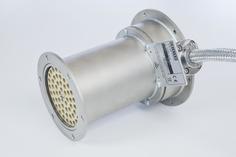|
At its most basic level, an air heater works by passing air across a heated element to elevate the temperature of the air. That hot air can then be used for a variety of applications ranging from heating a space to drying parts and coatings, or from de-flashing plastic components to heating parts in a manufacturing process.
Recommended reading in this series: Types of Elements Figure 1: A fully supported element in a Leister DF-R air heater. Figure 1: A fully supported element in a Leister DF-R air heater.
Most electric air heaters use coiled elements. Coil elements are made by winding resistance wire on a mandrel, either with a known pitch (the distance between windings) or by starting with a close wound geometry and then expanding the wound wire to the desired pitch. The total length of resistance wire required is determined by the required power of the heater and the supply voltage. The wire element is coiled to make it compact enough to fit into the heater package.
Coil elements can be divided into two categories:
The Practical Effect of Element Type
The primary practical difference between open elements and fully supported elements is the pressure drop across them. Fully supported elements result in a greater pressure drop because the structure of the coil and support imposes greater restrictions on air movement. Open element heaters can achieve higher flow rates at lower operating pressures because of their more open structure, but often have lower maximum operating temperatures due to the different support materials used. Read our article on Understanding Blowers as part of System for more information about pressure drop and how it influences other choices in a system.
A typical high flow rate industrial heater using open elements may be capable of reaching temperatures of approximately 450°C. A heater using fully supported elements generally results in a lower flow rate but is capable of reaching much higher temperatures – up to 650°C or even 850°C depending on the manufacturer and model. Many people make the mistake of choosing a heater/blower combination from a catalogue based on maximum flow or temperature values; in reality, there are many factors that influence the correct equipment choice. When you contact your heater supplier they should ask for details of your application to be sure you are choosing the appropriate equipment. If they don’t, we suggest you consider finding an alternate supplier who can ensure that the equipment you purchase is right for your application. Continue reading: Air Heater Basics Part Three: Choosing an Air Source Comments are closed.
|
|
STANMECH Technologies Inc.
944 Zelco Drive Burlington ON L7L 4Y3 | 1-888-438-6324 | [email protected] Terms of Use Privacy Terms and Conditions of Sale Warranty Policies |
|
Proud Member of:

